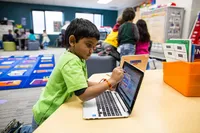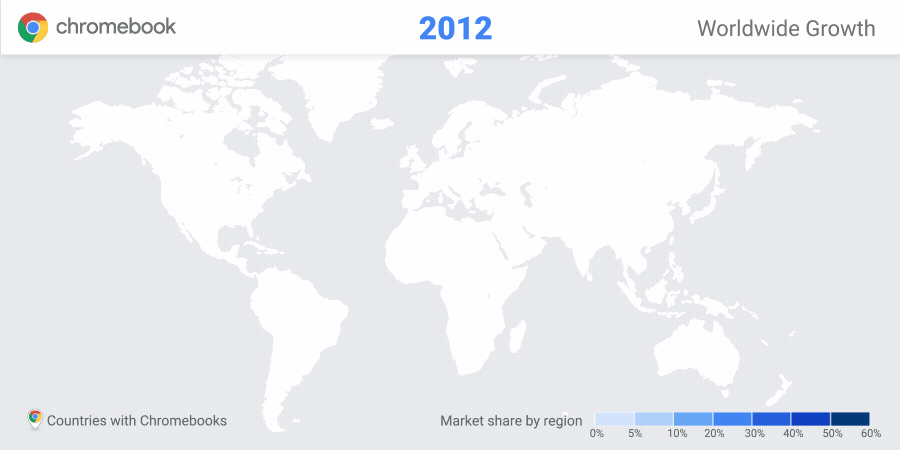All types of Chromebooks for all types of learners

Editor's note: This week our Google for Education team will be joining thousands of educators at Bett in London. At our booth, C230, you can explore a range of Chromebooks, including devices that flip from laptop to tablet, integrate with a stylus and have world facing cameras. Follow along on The Keyword and Twitter for the latest news and updates.
In late 2017, a snowstorm clobbered Wheatley Park School, a secondary school just east of Oxford, England. Determined to continue learning despite the snow, teachers grabbed their Chromebooks and sent a message through Google Classroom to students at home stating “learning must go on!”
In the following days, teachers broadcast live lessons (much to the dismay of would-be sledders) using touchscreen Chromebooks. They used Cast for Education to share screens, and recorded everything so students could watch later with a cup of cocoa in hand. Having Chromebooks “was wonderful to not only satisfy parents but also, genuinely, for learning not to halt,” said Head Teacher, Mr. Martin.
The ability to adapt to unexpected learning scenarios and a wide variety of learning styles is a cornerstone of Chromebooks. At Bett, we’re excited to announce a diverse lineup of 2018 Chromebooks including two next generation Chromebooks: the Lenovo 500e Chromebook and Dell Chromebook 11 2-in-1 5190. With cameras on two sides, stylus capability, larger screens, Intel® Celeron™ processors and laptops that flip into tablets, these Chromebooks are designed to be flexible for students with tools to learn in the way that’s right for them. We are also announcing a range of 2018 Chromebooks from Acer, HP, Dell, Asus and Lenovo in many shapes, sizes and price points, so there’s a device that works for every learner. Check out our Chromebook education site in the coming weeks.

Everyone learning everywhere
As the variety of Chromebooks has expanded, so too has the range of students using them to learn. Today, we’re excited to announce that more than 25 million teachers and students are using Chromebooks for education globally and 30 million teachers and students are using Google Classroom, along with the 80 million using G Suite for Education. Schools in more countries are choosing to use Chromebooks, and we’ve seen educators around the world employ the simplicity of these tools to bring the best learning opportunities to their students.

How schools around the world use Chromebooks for STEAM
Wheatley Park is an example of how determined teachers without a big budget can change how students learn. Extreme weather aside, Wheatley Park makes learning more than productive—it’s creative. In math class, students solve problems on Chromebook touch screens in an app developed by the instructor. Chemistry students use wireless temperature and PH probes with their Chromebooks and the SPARKvue app to collect, analyze, and visualize data all in one place. Instead of a more traditional whiteboard, students take notes using Sketch—then the notes are filed away in Google Keep where they’re never lost.With Chromebooks, students of all ages can practice communication, collaboration, critical thinking and creativity skills.
Educators in the Ames Community School district in Iowa, U.S., take advantage of Chromebook features like touch screens, stylus and Android apps to reimagine learning and get students into STEAM. Using Tinkercad, middle school students design, proof, and 3D print their own projects with Chromebooks and four 3D printers. These students manipulate designs on touchscreen Chromebooks for in-class projects and in “Tinker Tutorials” during their free time to design a lightsaber or whatever tool they can dream up.
Elementary school students at the Ames school district also use Chromebooks for STEAM. Kindergarteners use their “magic pencils” (as they call stylus pens) to write on their screens and practice counting. First graders open the day’s lesson in Google Classroom by rewriting some code cleverly disguised as a game in the Scratch app. Groups of three and four students use Hummingbird robotics kits and their Chromebooks to bring to life all sorts of loud, blinking, and walking creations. They take turns programming and reprogramming with Sphero (round and rolling robots—think headless BB-8s) and driving them around a racetrack.
We’re constantly inspired by educators who use technology to delight students and engage them more deeply in learning. Stay tuned on The Keyword and Twitter for more shared stories from educators throughout 2018.






